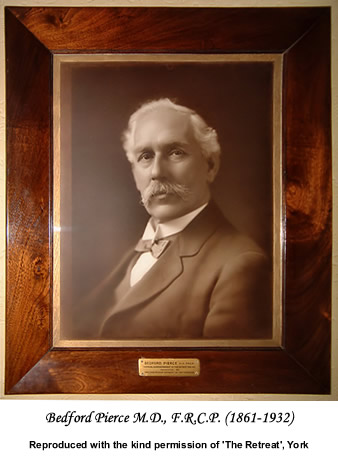Words such as lunatic, insane, idiot and mental asylum don’t sit comfortably in today’s world, but in Victorian England these terms were entirely commonplace when referring to mental illness. Asylums were grim places where people with all sorts of problems were grouped together, with treatment usually comprising of restraint by chains and manacles and the use of often damaging medications.

In 1792 a new style of ‘hospital’ was envisaged by tea merchant William Tuke, the head of a Quaker family living in York. Over the next five years about £3,500 was raised, mainly by subscription from members of various Quaker meetings and this money funded the purchase of eleven acres of land on which was built accommodation initially sufficient to accommodate about thirty patients (numbers approached two hundred by 1900).
The new ‘hospital’ was named ‘The Retreat’ to convey the idea of a quiet haven, rather than a hospital or an asylum. It was recognised that good food and clean surroundings aided patient’s wellbeing. Harsh medications were not administered, but patients were encouraged by moral, rather than violent, methods to control their own behaviour. Training was given in re-socialization and patients were rewarded for good behaviour. They were also given useful occupations and were valued as people despite their problems. This approach, which was a far cry from that found in other mental institutions of the time, was widely derided, but today the work carried out by staff at The Retreat in the 19th century is considered pioneering in the treatment of the mentally ill.
In the early summer of 1860 a young newly married couple moved from the south of England to Manchester and opened a boot and shoemakers shop at 19 Swan Street in Ancoats. They were Edmund Kell Pierce, born in Hobart, Van Diemen’s Land, the son of an Isle of Wight draper, and his wife (my distant cousin) Eliza Ann (née Tyler) from Reading.
In May 1861 Eliza had their first child ‘over the shop’ who they named Bedford Pierce. Maybe they hoped to have a large family, but this was not to be as when Bedford was about six months old his father died. Eliza and her son moved back to Reading where she ran a wool shop with her unmarried sister. Eventually, Eliza did remarry, but this was not until she was well into her 40s and there were no more children, so Bedford was brought up as an only child.
Bedford and his family were all members of the Society of Friends (the Quakers) and he attended the Friends’ School at Croydon and later, after a spell as a chemist’s apprentice in Liverpool, he took up studying medicine at London University, entering St Bartholomew’s Hospital in 1884 where he graduated with first class honours in forensic medicine. In 1890 he passed the M.D. examination and in 1892 was appointed medical superintendent of The Retreat at York.
As a Quaker, Bedford was entirely sympathetic to the methods used at The Retreat and perceived it to be a model institution for the enlightened treatment of patients suffering from mental illness. However, he did introduce modern principles of administration and devoted himself to the improvement of the training and status of mental nurses, raising the standards of their education and examination. A new nurses’ home was established at York where annual lectures by eminent medical men were given. Nurses were also sent on conducted holidays abroad for the advancement of their education.
Bedford took up various different appointments during the years he worked at The Retreat. He was chairman of the Royal Medico-Psychological Association and of the psychiatry of the Royal Society of Medicine. He was also an associate member of the Société Médico-Psychologique of Paris and a member of the Society of the New York Hospital. From 1908 until 1911 he was lecturer on mental diseases at Leeds University and had a consulting practice in that city. Bedford was elected a Fellow of the Royal College of Physicians of London in 1905.
In 1922 Bedford retired from his position at The Retreat after thirty years service. He travelled during his retirement years, visiting Africa, India and America. He still maintained an active role in medicine and in 1929 was made a Commissioner of the Board of Control under the Mental Deficiency Act. He also wrote a great deal on the history of psychiatry, on diagnosis of depression, on potential recovery from mental disorders and on the absence of sufficient facilities for treating mental illness.
Bedford’s granddaughter remembered him as a popular man and an excellent public speaker. He was amusing and courteous, a man who loved life and who was an earnest student in his speciality of psychiatric care.
Bedford Pierce died on 8th July 1932 at his daughter’s home in Harpenden, Hertfordshire.
Merry Monty Montgomery
© Merry Monty Montgomery 2009
SOURCES and FURTHER READING
Ancestry
General Register Office (GRO)